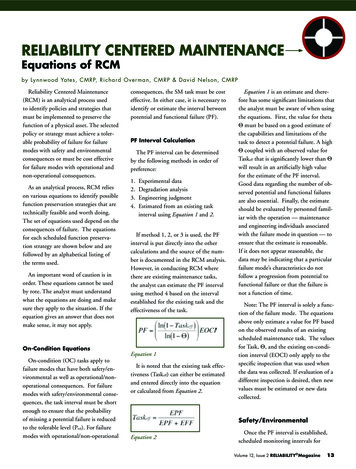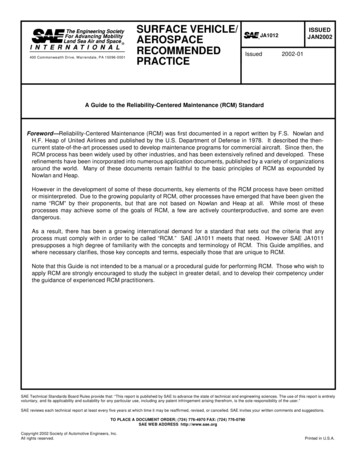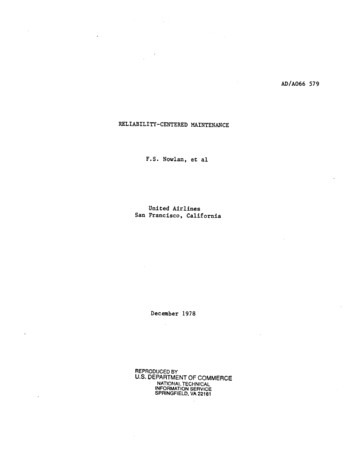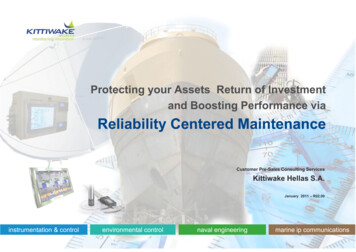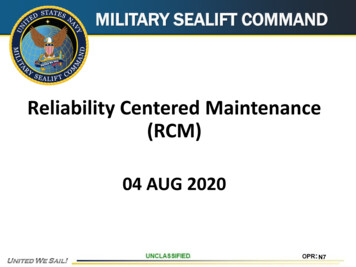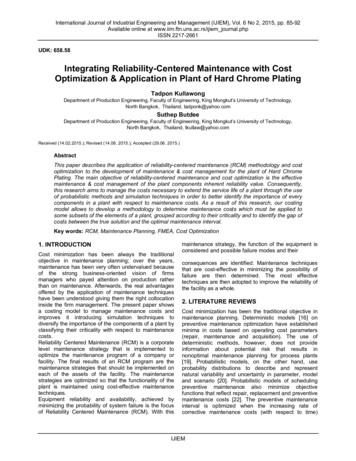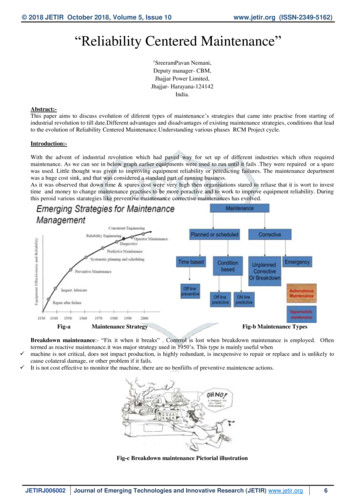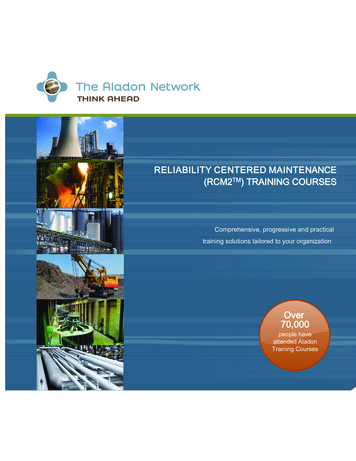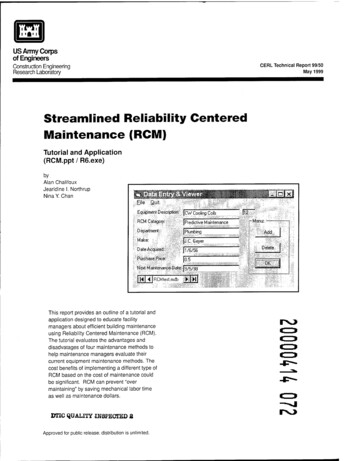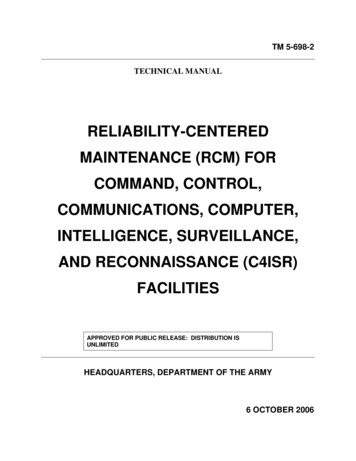
Transcription
J. Appl. Res. Ind. Eng. Vol. 5, No. 3 (2018) 205–222Journal of Applied Research on ble Reliability Centered Maintenance OptimizationConsidering Risk AttitudeAli Karevan1, Mohammadreza Vasili2 1Department2Departmentof Industrial Engineering, Islamic Azad University, Najafabad Branch, Iran.of Industrial Engineering, Islamic Azad University, Lenjan Branch, Isfahan, Iran.PAPERINFOChronicle:Received: 06 July 2018Revised: 16 August 2018Accepted: 11 November e.Risk Attitude.Multi-objective Particle SwarmOptimization.Internet TelecommunicationsEquipment.ABSTRACTMaintenance costs are one of the major costs in plants and companies. Theobservation in many cases illustrates the lack of plans or mistakes in maintenanceactivities that incurred great costs. In this study, the number of equipment failureshave been determined. Then the failure rate and reliability of each equipment arecalculated. The third step calculates total system reliability so the initial plan ispresented. After that, by using the obtained information, the sustainability aspectsof the program will generate and the maintenance costs and sustainability functionswill assess. At the end, this multi-objective optimization problem is solved byMOPSO algorithm and the results are compared with a simulation method. As aresult, with this reliability centered maintenance program, the reliability of eachequipment, as well as the whole system are improved; economic aspect ofsustainability and customer satisfaction are increased; environmental pollutions andmaintenance costs are decreased by offering more reliability based program; ascheduling plan for each maintenance procedures is provided and also more stableinternet connection is established by reducing the system failures.1. IntroductionIn today’s world of fast-moving global economy and fierce competition, maintenance has beenrecognized as a key factor to quickly respond to market opportunities. Maintenance is no longerregarded as being a necessary evil concerned primarily with corrective actions, but rather as a means toan end, which significantly contributes to the achievement of the organization’s main objectives.Maintenance involves actions to control or prevent deterioration process that may lead to device failuresand returns that equipment to its operational condition through corrective maintenance [1]. Theimportance of maintenance becomes greater due to its unique role in preserving and improving productquality, accessibility, and also safety requirements. Therefore, selecting the appropriate maintenancestrategies is one the most important decision-making activities in various industries [2]. Maintenancein factories and industrial places plays a critical role to determine productivity. The main aim ofmaintenance is reaching to the least failures and keep devices at the lowest possible cost of operatingcondition. Therefore, maintenance shouldn’t be considered as a costly activity, but also consider as aprofit generating operation. Maintenance also increases different aspects of business like productivity Corresponding authorE-mail address: Reza.vasili@hotmail.comDOI: 10.22105/jarie.2018.79157
Karevan and Vasili / J. Appl. Res. Ind. Eng. 5(3) (2018) 205-222206and profitability. The loss output of a day that arising from an unplanned stop, never reverses withoutadditional costs such as overtime working and rewards to employees [3].Various approaches have been investigated by researchers to cope with maintenance problems in thepast decades as the concept has gained popularity. These may include lean maintenance and TotalProductive Maintenance (TPM) [4]; proactive maintenance [5]; predictive maintenance [6]; Risk-BasedMaintenance (RBM) [7]; agile maintenance [8]; selective maintenance [9]; virtual maintenance [10],and so on.In the past decades, social, cultural, and technological changes have contributed to emergence ofquantitative treatments and rational frameworks for the reliability analysis of engineered systems [11].Numerous books and papers are witnesses of this fact [12-14]. In this regard, Reliability CenteredMaintenance (RCM) is an effective way to proceed for establishing maintenance programs in practice[15, 16]. It directs maintenance efforts towards those systems and sub-systems which are critical interms of reliability, production regularity, and safety [11]. However, the basic approaches are notsufficient to cope with many realistic settings. Therefore, many of their extensions have been consideredand extensively studied [17-19].Many studies have focused on development of maintenance optimization models to identify the bestsuitable maintenance actions and strategies [20-23]. Such models can be of different types, but they areall tools for balancing costs and benefits. By investigating the relationship between costs and benefitsassociated with each maintenance alternative, the optimal blend of maintenance strategies can bedetermined [24].Recently, the concept of sustainability has attracted much attention of both academics and practitioners,however contributions which apply this concept in maintenance problems are very few. Keivanpourand kadi [25] proposed a conceptual framework to simultaneously integrate reliability, economic,environmental and social performance of maintenance activities. Saniuk et al. [26] investigated the roleof maintenance in the sustainable developing practices. Ba et al. [22] presented a joint optimization ofpreventive maintenance and spare parts inventory, while minimizing CO2 emissions. Sabatino et al. [27]proposed a sustainability-based maintenance optimization problem of highway bridges which providesdecision makers with optimal life-cycle maintenance actions. The main objective of their frameworkwas to reduce the extent of the impact of structural failure to sustainability dimensions. Their biobjective problem was solved using a GA-based optimization approach.As mentioned above, almost all research papers conducted with reducing maintenance costs as aprimary goal. Providing maintenance schedule can both reduce costs and systemize this process invarious industries. In RCM method that is also focused on this study, there are some important goalssuch as reliability, reduce mean time to failure, reduce failure probability and improve quality.Sustainability in maintenance is a new and hot topic for researchers but there isn't many studies in thisfield and most of those papers that research in this area, just identified the sustainability aspects. Theseissues motivate us to introduce RCM approach that considers risks on sustainability aspects. Then thisproblem has been solved by MOPSO. Rest of the paper is organized as follows: Section 2 describes theMethodology, Section 3 introduces the MOPSO algorithm, Section 4 illustrates results and Section 5provides conclusions.
207Sustainable reliability centered maintenance optimization considering risk attitude2. MethodologyThe methodology of this study is an extension of the work by Sabatino et al. [27] to simultaneouslyincorporate reliability and sustainably-based procedures into an optimization procedure. The first stepis introducing the list of intended equipment or devices and determine the system boundary. In fact, theidentified those items that could effect on equipment and system [1]. In next step, maintenance expertsneed to highlight the potential equipment failures and determine that each equipment suffers what kindof damages and then try to find the critical causes of each of these failures. After that, expert shoulddetermine the harmful consequences of these failures [28]. All of this information can be taken byhistorical archive and general interviews with industrial maintenance experts.In next step, according to the number of equipment failures during a time period and regarding itsdistribution, the reliability of each equipment has been specified and as a result, the system reliabilitycan be calculated. After that, the risks of each aspect of sustainability has been identified. This can bedone by using questionnaires or interviews with industrialists. It is obvious that the next step would beaccessing these identified risks aspects of sustainability.Eq. (1) calculates the reliability for each equipment and Eq. (2) assesses the most important formula System Reliability- that creates a connection between two main objectives.βR i e (t/θ )(1)nRT Rii 1, , n(2)i 1In the next step, the risks associated with the sustainability dimensions are identified based on experts’opinions. Eq. (3) denotes the 1st risk attitude for economic impact [29]. This formula calculates therelaunch equipment costs risk. Eq. (4) denotes the 2nd risk attitude for economic impact [30]. It assesseslost profits risk due to the dissatisfaction of costumers and the probability of changing their company.RA ECO1(t) RAECO2(t) (1 R T ) ni 1 Ci, i 1, , n(1 rm )t(1 R T ) [(nm z ch fh ) (nm (1 z) cf ff )](1 rm )t(3)(4)In Eq. (5), MDT shows the mean down time and it will be obtained by 9 different times that involvesrealization time, access time, diagnosis time, spare part procurement time, replacement time, check outtime, alignment time, logistic time, and administrative time [31]. This equation evaluates 1st risk attitudefor social impact and uses for assessing subscriber lost time risk. Then, in Eq. (6) the distance imposedto subscriber risk has been evaluated [27]. Also, Eq. (7) represents the cost per hour lost risk [30].
Karevan and Vasili / J. Appl. Res. Ind. Eng. 5(3) (2018) 205-222208TSTSRASOC1 (t) (1 R T ) [O1 () O2 (1 )] MDT nm100100(5)RASOC2 (t) (1 R t ) dm fm(6)RASOC3 (t) (1 R T ) [Chh (TSTS) Chf (1 )] MDT nm100100(7)Eq. (8) and (9) illustrate the carbon dioxide generated risk and the amount of energy consumed risk,respectively [27, 32].RAENV1 (t) (1 R t ) (CD) [(fm dm ) (fr dr )](8)RAENV2 (t) (1 R t ) (EC) [(fm dm ) (fr dr )](9)A number of time-based maintenance actions are specified as all possible required actions for the systemand its components, so that the final optimal maintenance plan is a set of these actions. A maintenanceaction is assigned to a component based its desired level of reliability, which itself is based on thepercentage failure that can be tolerated by that component as its acceptable failure level. Eq. (10)calculates the maintenance costs for each maintenance action [33].NCCMaintenance (CM1,i (dD1,i ) CM2,i (dD2,i ) CM3,i (dD3,i ))(10)iA maintenance plan details the type and timing of maintenance actions and it desirability depends onthe risks-attributes associated with the sustainability dimensions. In other words, the risk-attributescapture the economic, social, and the environmental consequences of failures. However, these risksattributes are measured with different units and thus are not directly comparable. This implies need forestablishing a consistent range of values that each attribute may take. Therefore, the utility theory isused to normalize the value of each attribute to a number between 0 and 1. The formulation of the utilityfunction corresponding to each attribute depends largely on the knowledge and preferentialcharacteristics of the decision maker.Below, Eqs. (11-17) describe the utility function for each sustainability aspects. They can be riskaversion (γ 0) and risk-acceptation (γ 0) [27].URAECO1 1RAECO1max RAECO1 [1 exp ( γ )]1 exp( γ)RAECO1max RAECO1min(11)URAECO2 1RAECO2max RAECO2 [1 exp ( γ )]1 exp( γ)RAECO2max RAECO2min(12)URASOC1 1RASOC1max RASOC1 [1 exp ( γ )]1 exp( γ)RASOC1max RASOC1min(13)URASOC2 1RASOC2max RASOC2 [1 exp ( γ )]1 exp( γ)RASOC2max RASOC2min(14)
209Sustainable reliability centered maintenance optimization considering risk attitudeURASOC3 1RASOC3max RASOC3 [1 exp ( γ )]1 exp( γ)RASOC3max RASOC3min(15)URAENV1 1RAENV1max RASOENV1 [1 exp ( γ )]1 exp( γ)RAENV1max RAENV1min(16)URAENV2 1RAENV2max RAENV2 [1 exp ( γ )]1 exp( γ)RAENV2max RAENV2min(17)Monotonically decreasing functions are used to effectively represent the relative utility of detrimentalconsequences of the failures. The final utility function takes into account the weighted relative utilityvalue corresponding to each attribute involved. It is important here to note that each major attributewithin the presented approach may be associated with several sub-attributes, which are incorporatedinto the function by using the same approach as described above.This function depicts a sustainability metric that effectively weighs the extent of impacts to theeconomy, society, and the environment. At the end, Eq. (18) illustrates the first objective that describesthe amount of sustainability. Each sustainability aspects, based on decision-maker has its own weight(KECO, KSOC and KENV). The summation of both 3 aspects, describes the total sustainability function, andEq. (19) shows the second objective that describes the maintenance costs utility function. The higheramount of this 2 objective gives better performance.US Max [(K ECO1 UECO1 ) (K ECO2 UECO2 ) (K SOC1 USOC1 ) (K SOC2 USOC2 ) (K SOC3 USOC3 ) (K ENV1 UENV1 ) (K ENV2 UENV2 )](18)1Cmax CMaintenanceUC Max ( [1 exp ( γ )])1 exp( γ)Cmax(19)The proposed optimization model is adjusted for the maintenance activities of a local Internet ServiceProvider (ISP). Through this, an optimal maintenance plan is specified for the ISP’s equipment (i.e. anumber of server racks contain multiple electronic modules) that are located in the midtown buildingof the telecommunications company.Each single attribute may monotonically decrease functions that are employed to effectively depict therelative utility of detrimental consequences of the failures. A final multi-attribute utility function isdeveloped that considers the weighted relative utility value corresponding to each attribute involved.This function represents a sustainability metric that effectively weighs the contribution of impacts tothe economy, society, and the environment.The utility theory is applied to normalize the values of sustainability and maintenance cost to numbersbetween 0 and 1. The formulation of the utility function corresponding to each factor depends largelyon the knowledge and preferential characteristics of the decision makers. The final utility function takesinto account the weighted relative utility value corresponding to each attribute involved. It’s clear thatincreasing the utility theory could give better performance. So, the main aim is to maximize both goalfunctions. Table 1 shows the parameter definition of this study.
Karevan and Vasili / J. Appl. Res. Ind. Eng. 5(3) (2018) 205-222210Table 1. Parameter ffhffdDi,jCMi,jNCChhChfDefinitionSystem Reliabilitylaunching Cost for device iUsage rate for Household consumers per ADSL lineUsage rate for Household Corporate per ADSL lineThe average household subscribers percentage of total server trafficMean Down TimeThe number of failure reports announced annuallyThe average distance of customer's home to the corporateThe number of subscribers come to company annuallyThe average distance of corporate to telecommunications companiesThe number of experts went to telecommunications companies annuallyThe amount of energy consumedThe amount of carbon dioxide producedRiskFailure announced percentage for home subscribersThe average cost per household serviceThe average cost per corporate serviceThe dissatisfaction percentage of failures announced with household subscribersThe dissatisfaction percentage of failures announced with corporate subscribersIf equipment i order j maintenance methodMaintenance cost for equipment i when j maintenance method performTotal number of equipmentInternet outages cost per hour for household subscribersInternet outages cost per hour for corporate subscribersUnit% 2Number% %%0,1Variable Number 2.1 Case StudyThis work performed in Sabanet ISP1 Internet Service Provider Company located in Isfahan, Iran. Thiscompany like other ISP companies has a number of racks located in one of the telecommunication’scompany’s rooms called PAP room. In these racks, there are some equipment and devices that haveconnected to each other. Eight equipment are identified in racks. These types of equipment are the firstand the most important point to get permission to access the internet. If one of these equipment fails,people who used this ISP couldn’t access the internet. So the most critical place for these companies isperforming the best maintenance activities to reduce the failure probability for these equipment. Fig. 1shows the rack equipment of this ISP Company.1Internet Service Provider
211Sustainable reliability centered maintenance optimization considering risk attitude47 UPDB2U10 UESMBEADAEADAEADAEADA01234567ISU89 1011121314DSLAM 5300152UDSLAM Cable2UDDF1UMikr oTik RB-4503URouter AR-461U5USwitch 2960DC AC1 1 1 1 1E E E E E1 1 1 1 1Shelf convertor1U6UShelf45Cruise Terminal1U6UShelf122331UCruise TerminalShelf2UAC panel (Old)Huawei Rack60cm * 60cm * 47UFig. 1. Rack equipment.In the first step, the intended equipment must be identified. Based on the equipment history and thenumber of failures in the desired timespan, the failure rate of each equipment calculates. The next stepreferres to determine the relevant distribution and assess the reliability of each equipment. Then thetotal system reliability is calculated. In next step, the risks of each aspect of sustainability is identified.In this study, two risk instances were determined for economic aspect: Lost profits risk and relaunchequipment costs risk. Two risk were considered for environment aspect: The carbon dioxide generatedrisk and the amount of energy consumed risk. And finally, three risks were considered for social aspect:Subscriber lost time risk, Distance imposed to subscriber risk, and the cost per hour lost risk. Fig. 2describes the proposed algorithm to solve this problem.
Karevan and Vasili / J. Appl. Res. Ind. Eng. 5(3) (2018) 205-222StartPreparing thecompany s equipmentlistDetermine the failurerate and reliability ofeach equipmentSpecify the number ofequipment failuresHighlight systemreliability anddetermine the failurecausesProviding primary maintenance programCalculate the numberof subscribers andexperts transportationsCalculate theenvironmental risksPrepare aquestionnaire forcustomer satisfactionCalculate the socialrisksCalculate theeconomic risksSolving multi objective problem with MOPSO algorithmImproving RCM programregarding to reduce risks ofsustainability aspectsFig. 2. Proposed algorithm.Calculate the cost ofeach maintenanceprocedureCalculate maintenancecosts212
213Sustainable reliability centered maintenance optimization considering risk attitude3. MOPSO AlgorithmParticle Swarm Optimization (PSO) is a stochastic optimization technique that is similar to evolutionaryalgorithms. This algorithm has been modeled after the invasion and accumulation of animals and theirbehaviors. Unlike other methods, PSO doesn’t produce new samples. This algorithm doesn’t select anysample, instead, PSO saves a significant statistically population whose members were optimized inresponse to new discoveries. This technique was developed by James Kennedy and Russell Eberhart in90s [35].Like as differential evolution, PSO almost exclusively works in multidimensional space and on realintervals, because the PSO candidate answers mutated to discover the best solution that really requiresa metric space. Due to using in real spaces and because the PSO has been inspired by swarms, PSOalgorithm tends to referral to candidate answers as a particle swarms. These particles never die. Incontrast, mutations execute in surrounding space and replaced particles. A particle consists of two parts:Particle place in the space and particle velocity. Each particle will start at a random location with arandom velocity vector [34].PSO algorithm is different from evolutionary algorithms. These differences are in the parents’ nature,selecting, and parameter setting method that are mentioned in the following: In PSO, parents’ information includes the shared particle evolutionary optimization.PSO doesn’t include an explicit selection function of processing evolutionary optimization.PSO uses a guided mutation operator to manipulate individuals.There is no mechanism for PSO to adapt velocity step for the right amount of space.In MOPSO, the velocity and position update are equals to what has been in a single PSO. All parametersare like PSO algorithm except the objective function that is a multi-objective. The mathematical formulafor MOPSO is as follows:Vit 1 wVit c1 r1 (xpbest Xit ) c2 r2 (xgbest Xit )(20)Xit 1 Xit Vit 1(21)That w equals the inertia weight, c1 is the cognitive acceleration factor, c2 is the social accelerationfactor, r1 and r2 are the random variables between 0 and 1, xpbest is the best individual particles, xgbest isthe best global particle, X it equals the current situation of i-th particle in iteration t and Vit 1 is the ithparticle velocity in iteration t [35]. Multi-objective particle swarm optimization algorithm basis is asfollows: Create the initial population.Initialize the velocity each particle.Evaluate each particle of the population.Separating non-dominated members of the population and store them in another archive.Tabulation the discovered purpose.Each particle of the archive, select the leadership and moves.The best memory of each particle is updated.Non-dominated members are added to the current population archive.
Karevan and Vasili / J. Appl. Res. Ind. Eng. 5(3) (2018) 205-222 214Dominated archive members will be deleted.If the archive numbers exceed the determined capacity, additional members will be removedIf the conditions are not fulfilled, then returns to Step 5; otherwise, stop the algorithm.4. ResultsIn the first step as we highlighted before, we identified the critical equipment and calculate the failurerate and reliability based on the number of failures and mean repair time in 1 year that are demonstratedin Table 2. It must be noted that these values are the current situation of the company. By testing thetime between failures of each equipment, the Weibull distribution was used to calculate their reliability.Then the total system reliability was evaluated and showed 0.01546. Then we defined a rule based onthe equipment reliability to identify its maintenance actions.Table 2. Reliability of equipment.EquipmentNumber .5682CopulativeCablesIf 0.8 𝑅𝑖 1.0 , then select the 1st maintenance action.If 0.5 𝑅𝑖 0.8 , then select the 2nd maintenance action.If 0.0 𝑅𝑖 0.5 , then select 3rd maintenance action.By this rule, the primary maintenance program was presented. Error! Reference source not found.illustrates the current situation of maintenance program based on the equipment reliability. Also, Table4 defines the amount of each parameter that was assumed in this study. Table 5 shows all times thatevaluate Mean Down Time.Table 3. Primary maintenance TerminalData 68212122332
Sustainable reliability centered maintenance optimization considering risk attitude215Table 4. Amount of lue5*10410*104 1 or ealizationAccessDiagnosisSpare cAdministrativeTimeTable 5. Mean down time.0.51.5First, we solved this multi-objective optimization problem with MOPSO with MATLAB (R2015a)software. For our experiments, we utilized a Personal Computer (PC) equipped with an Intel Core i5 5200 @ 2.20 GHz CPU and 8GB of RAM running Microsoft Windows 10 Ultimate . Table 6illustrates the values that used in this algorithm for solving the problem.
Karevan and Vasili / J. Appl. Res. Ind. Eng. 5(3) (2018) 205-222VariableIterationPopulation sizeRepository SizePersonal learning coefficientGlobal learning coefficientMutation rateLeader selection pressure (β)Deletion Selection PressureInertia Weight216Table 6. Values used in the algorithm.Value300503002255%320.7We want to solve this problem either for risk-acceptance models and risk-aversion models. It’s clearthat in the different iteration of the algorithm we may take different solutions. Table 7 represents thebest solutions that MOPSO found between all possible solutions for risk-acceptance models. As itshows, there are four optimal maintenance programs that are different in their objectives amounts. Thegoal is to maximize both objectives. All of these solutions give better performance than the currentprogram. This iteration was implemented in 17.449 seconds.[1 1 1 3 1 1 1 1][1 1 2 3 1 1 1 1][1 1 1 1 2 1 1 1][1 1 1 1 1 1 1 mentSocialThe proposedmaintenance programEconomicThe objective amounts of each enance costTable 7. Proposed maintenance program with MOPSO for risk-acceptance models.0.90890.90700.91350.9273Fig. 3 shows the Pareto optimal solutions for risk acceptance models. Fig. 4 specifies that whensustainability utility increases, the maintenance cost utility decreases. But the differences between themare very close and negligible. Also, Fig. 4 proposes maintenance program objective functions for riskacceptance models. Fig. 5 represents the sustainability aspects of this program and all three aspects,increase constantly and have been placed in the range of [0.85-0.99].
Sustainable reliability centered maintenance optimization considering risk attitude217Fig. 3. Pareto optimal solutions for risk-acceptance ce ProgramSustainabilityMaintenance CostsFig. 4. Proposed maintenance program objective functions for risk-acceptance models.10.950.90.850.80.75123Maintenance ProgramEconomicSocialEnvironmentFig. 5. Sustainability aspects for risk-acceptance models.4
Karevan and Vasili / J. Appl. Res. Ind. Eng. 5(3) (2018) 205-222218Now, we concentrate on risk-aversion models. Like previous one, MOPSO algorithm ran for findingthe best solutions. Table 8 proposes maintenance program with their objective function values. Thisiteration was implemented in 18.561 seconds.EconomicSocialEconomicThe proposed maintenanceprogramTotalsustainabilityThe objective amounts of each programSustainabilityMaintenance costTable 8. Proposed maintenance program with MOPSO for risk-aversion models.[1 2 1 2 1 1 3 3]0.940.960.960.95270.7263[1 1 1 1 1 1 1 1]0.890.810.880.85820.8243[1 1 1 1 1 2 3 1]0.950.940.950.94660.8128[1 2 1 2 2 1 2 3]0.970.940.970.96010.7015In this iteration, accidentally, four optimal solutions were obtained. As it has been specified in Fig. 6,the objective values are not good as risk-acceptance one. Fig. 7 demonstrates this problem better. Likeprevious one, by increasing sustainability utility, the maintenance costs utility decreased but the mostdifferences with that are the maintenance utility values which much less than the risk-acceptance model.On the other hand, the sustainability aspects increase during these four programs that are recognized inFig. 8.Fig. 6. Pareto optimal solutions for risk-aversion models.
Sustainable reliability centered maintenance optimization considering risk 0000.65000.60000.55000.50001234Maintenance ProgramMaintenance CostsSustainabilityFig. 7. Proposed maintenance program objective functions for risk-aversion models.10.950.90.850.80.750.71234Maintenance ProgramEconomicSocialEnvironmentFig. 8. Sustainability aspects for risk-aversion models.All of the Pareto solutions that were determined above can be used as an optimal maintenance strategywith the maximum amount of both objective functions. It must be noted another time, because of thevarious number of strategies, we decided to solve this with a meta-heuristic algorithm. It may take anillogical solving time if we want to use such an exact method. By viewing the solutions, we can identifythat MOPSO gave better performance with better results in a very short time; furthermore, it gave morediverse solutions so the decision-maker can choose the maintenance strategy more easily.It is important to know that the upper and lower limits of sustainability aspects, could effect on solutionsquality. Another one is the sustainability aspects weights that refer to decision-maker and the type ofthe problem. In this study, we assumed 0.40 for economic aspect, 0.35 for the social aspect, and 0.25for environment aspect.
Karevan and Vasili / J. Appl. Res. Ind. Eng. 5(3) (2018) 205-2222205. Conclus
207 Sustainable reliability centered maintenance optimization considering risk attitude 2. Methodology The methodology of this study is an extension of the work by Sabatino et al. [27] to simultaneously incorporate rel
